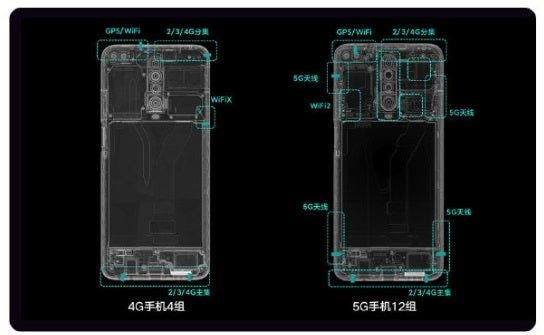Xiaomi Group Vice President, General Manager of Redmi Brand, Lu Weibing introduced the issues related to 5G smartphones in detail. He said that for a 5G smartphone, it is not as simple as adding a 5G modem. It requires a systematic redesign of the platform, structure, heat dissipation, and antenna.
After using as many highly integrated components as possible, the total number of components has increased by more than 500. The PCB area has also increased by about 20%. Just imagine how difficult it is to add so many components inside the phones.

There are only 4 groups of conventional 4G smartphone antennas, including 2/3/4G antennas at both ends, GPS/Wi-Fi/Bluetooth three-in-one antenna, and an independent Wi-Fi antenna. If the phone supports NFC, add another antenna for this purpose. In 5G smartphones, the number of antennas is directly increased to more than 12 groups. In addition to 4G smartphone antennas, the manufacturers have to add multiple sets of 5G band antennas.
The increase in the number of antennas has brought more slotting in the machine frame. It is not only to slot 5G antennas but also to ensure the structural strength of the middle frame after slotting. This is a huge test for the structural design of smartphones.
Gizchina News of the week
5G network has ultra-high network bandwidth, which consumes more power during peak downloads. Data power consumption is increased by 50% -100% compared to traditional 4G smartphones. The common cooling solution configuration will not be able to cope with such heat. That’s why most 5G smartphones use a liquid cooling system.
In addition to these, more important is the processor. The Redmi K30 5G will sport the world’s latest generation of 5G processor. Apart from the MediaTek Dimensity 1000, the original variant will sport the Snapdragon 765G.
This is Qualcomm’s latest 5G SoC. It adopts the latest generation of AP + Modem integrated solution. The new Snapdragon X52 Modem supports SA and NSA dual-mode 5G. As the external baseband requires additional interfaces to transmit data, and it will occupy a larger area, the Snapdragon 765G with integrated baseband can be described as the 5G optimal solution. Coupled with the advantages of the process, we can say this is one of the 5G processors with the best energy efficiency at present.






